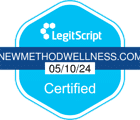Challenging circumstances are part of every human life. But sometimes, the intensity of an event exceeds the body and mind’s ability to fully process it. The word psychologists use to describe the mental-emotional response to such events is “trauma.”
Trauma is a psychological wound or scar. This response may develop into Post-Traumatic Stress Disorder (PTSD) or Complex Post-Traumatic Stress Disorder (CPTSD).
People who suffer from PTSD or CPTSD often relive the traumatizing event in flashbacks or nightmares. They might experience physical symptoms like insomnia and difficulty concentrating. In addition, they may experience a range of emotions, including fear, anxiety, anger, guilt, shame, sadness, or isolation.
The good news is that PTSD and CPTSD can be effectively treated. And the skilled therapists at New Method Wellness employ a variety of holistic modalities and evidence-based therapies to support healing.
But what’s the difference between PTSD and CPTSD? What are the symptoms of each, and how are they treated? This essay provides answers to these questions and more.
What is PTSD?
Post-Traumatic Stress Disorder (PTSD) is an anxiety disorder caused by intensely stressful, frightening, or distressing events. It is associated with symptoms such as emotional numbing, hyperarousal, re-experiencing (via flashbacks), and anxiety-induced avoidance.
In the aftermath of a distressing event, it is normal to feel upset and confused. Most people will experience temporary difficulty in coping with or adjusting to what just happened. However, there is hope for recovery and returning to a normal life without PTSD. PTSD treatment is often the best course of action to find recovery and peace.
There are a few signs that a person is struggling with PTSD. These signs include:
- • Particularly troubling symptoms
- • Symptoms get worse over time
- • Symptoms last for more than four weeks after the traumatic event
- • Symptoms are interfering with daily life
- • Experiencing impaired functioning
Sympathetic vs. Parasympathetic Responses
Traumatic events activate the “fight or flight or freeze” response of the body’s sympathetic nervous system. This response is useful in the face of immediate danger. However, there should be a return to the “rest and digest” mode of the nervous system when the danger has passed.
People suffering from PTSD may be stuck in the “fight, flight, or freeze” mode. This method of coping can occur for weeks, months, years, or decades after the traumatizing event.
What Causes PTSD?
Post-Traumatic Stress Disorder affects approximately one out of every three people who experience severe trauma. Why it develops in some people but not in others is still not fully understood.
Any event or situation that a person experiences as traumatic can lead to PTSD. Such circumstances may include:
- • Natural disasters: hurricanes, tornadoes, floods, wildfires, earthquakes
- • Serious auto accidents
- • Violent personal assaults: rape, sexual assault, mugging
- • Serious illness or injury
- • The death of a loved one
- • Traumatic childbirth experiences
- • Being threatened with death, sexual violence, or serious injury
- • Active military duty/combat
- • Living in a war-torn environment
- • Experiencing a terrorist attack
- • Being tortured
- • Domestic or emotional abuse
- • Bullying or sexual harassment
- • Racial trauma or hate-crimes
- • Covid-19 pandemic
- • Childhood abuse
- • Mass shootings
The Onset of PTSD Symptoms
PTSD symptoms may develop immediately after experiencing a disturbing event. But sometimes, these symptoms don’t emerge until many weeks, months, or even years after the event.
Post-Traumatic Stress Disorder symptoms can also vary in their intensity. They may subside for a while and then worsen. They may be triggered by surroundings or events that are reminiscent of the original trauma.
A loud door slam may cause a war veteran to relive the experience of being caught in a battlefield crossfire. A whispered voice of a certain tone may evoke memories of sexual assault.
PTSD Symptoms
Post-Traumatic Stress Disorder symptoms can vary from person to person and change over time. They are often severe enough to negatively affect the person’s day-to-day life and make it difficult to function.
The most prevalent of these PTSD symptoms fall into four basic categories:
- • Intrusive memories
- • Avoidance
- • Disturbances in thinking and mood
- • Changes in emotional and physical reactions
Intrusive Memories
Intrusive memory PTSD symptoms may include:
- • Flashbacks: reliving the traumatic event as if it were happening again.
- • Nightmares about the traumatic event.
- • Disturbing memories of the traumatic event.
- • Triggered responses: intense emotional distress and/or physical reactions to people, objects, or events that are reminiscent of the traumatic event.
Avoidance
PTSD avoidance symptoms may include:
- • Actively trying to avoid thinking or talking about the traumatic event.
- • Avoiding people, places, or activities that remind the individual of the traumatizing event.
Disturbances in Thinking and Mood
PTSD symptoms that involve disturbances in mood or thinking may include:
- • Feeling emotionally numb
- • Feelings of hopelessness about the future
- • Negative thoughts about oneself, other people, or the world
- • Memory problems, including not recalling key aspects of the traumatic event
- • Strained relationships: feeling detached from friends and family, and difficulty with trust and intimacy
- • Lack of interest in activities the person once enjoyed
- • Difficulty experiencing positive emotions
Changes in Emotional and Physical Reactions
PTSD symptoms that involve changes in emotional or physical reactions—also known as arousal symptoms—may include:
- • Unpredictable emotions
- • Constantly feeling on edge
- • Being easily startled or frightened
- • Feeling irritable or frustrated
- • Intense feelings of sadness, fear, or guilt
- • Always being on guard for potential dangers
- • Self-destructive behavior: drinking too much, using drugs, driving too fast
- • Aggressive behavior or angry outbursts
- • Overwhelming guilt or shame
- • Trouble concentrating
- • Headache or nausea
- • Difficulty sleeping
PTSD vs. CPTSD
What’s the difference between Post-Traumatic Stress Disorder (PTSD) and Complex Post-Traumatic Stress Disorder (CPTSD)?
The two conditions share many symptoms and are treated using basically the same healing modalities. The difference between these behavioral health conditions lies in the severity and occurrence of the traumatizing event.
Individuals who repeatedly experience a traumatic situation may be diagnosed with PTSD. These situations may include; ongoing sexual abuse or domestic violence, childhood neglect, or torture as a long-term prisoner-of-war. Repeated trauma will manifest as complex trauma in those affected.
What is CPTSD?
Complex PTSD is a form of PTSD typically diagnosed in people who have experienced ongoing or repeated traumatic events. The addition of this diagnosis is based on the understanding that traumas tend to be more serious in certain circumstances.
A person is more likely to be diagnosed with CPTSD rather than PTSD when:
- • The trauma occurred during their childhood.
- • The physical or emotional violation was perpetrated by someone they trusted, such as a parent or caregiver.
- • The trauma was ongoing: experienced for an extended period of time.
- • The traumatized person was alone during the event.
- • They still have regular contact with the perpetrator or the location where the trauma happened.
Symptoms of CPTSD
The symptoms of CPTSD are similar to those of PTSD but may also include:
- • Strong distrust of the world.
- • Feelings of hopelessness and helplessness.
- • Intense feelings of shame or guilt.
- • Extreme emotional volatility.
- • Dissociation: feeling detached from oneself and emotions.
- • Periods of losing attention and concentration.
- • Physical symptoms like dizziness, headaches, stomach aches, or chest pains.
- • Cutting oneself off completely from family and friends.
- • Avoidance of or difficulty maintaining relationships.
- • Extremely destructive or risky behavior, such as self-harm, alcohol abuse, or drug addiction.
- • Life and others seem distorted and unreal.
- • A confused sense of identity.
- • Suicidal thoughts or behavior.
Treatment for PTSD and CPTSD
The primary treatments for Post-Traumatic Stress Disorder (PTSD) and Complex Post-Traumatic Stress Disorder (CPTSD) are psychological therapy and medication.
If a person has PTSD that requires treatment, psychological therapies are usually recommended first. Trauma-focused psychological treatment often employs modalities such as:
- • Cognitive-behavioral therapy (CBT)
- • Dialectical behavior therapy (DBT)
- • Eye movement desensitization and reprocessing (EMDR)
- • Mindfulness-based cognitive therapy (MBCT)
- • Body-centered treatments such as Somatic Experiencing, body-oriented psychotherapy, and restorative yoga
For those who are experiencing severe or persistent PTSD or CPTSD, a combination of treatments can be helpful. For many people, a treatment approach that includes psychological therapy and medication may be most effective. The medications most often prescribed are a type of antidepressant known as selective serotonin reuptake inhibitors (SSRIs).
Getting Help
Traumatic events can be very difficult to come to terms with. The good news is that it’s possible for PTSD and CPTSD to be successfully treated. These disorders can be treated even many years after the traumatic event or events occurred. It is never too late to seek help!
At New Method Wellness, clients are able to focus on their healing in a peaceful, supportive environment. We pride ourselves on valuing community, fulfillment, balance, and integrity.
Our team of behavioral health professionals offers a combination of holistic therapies and evidence-based treatments. These methods are used to nourish, support, and inspire the unique healing journey of each individual.







